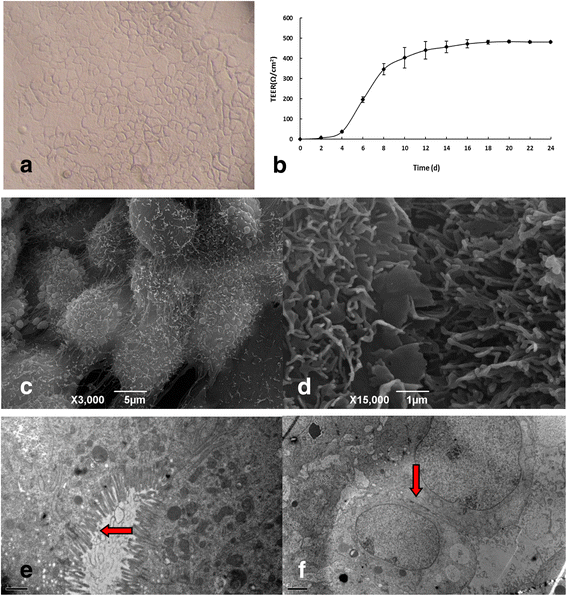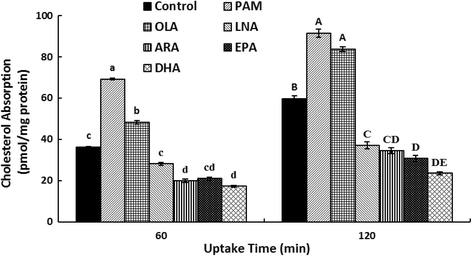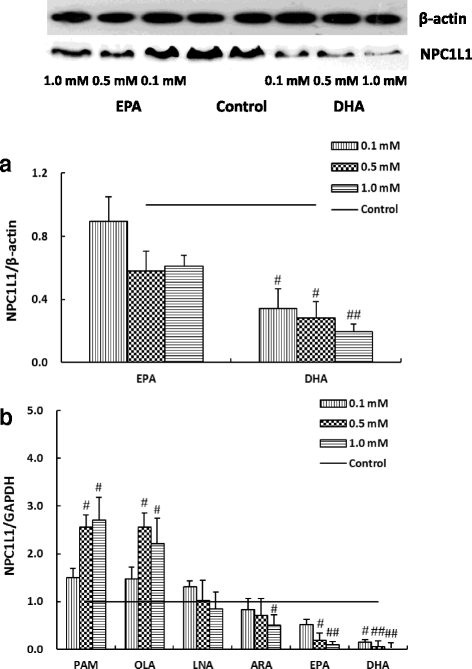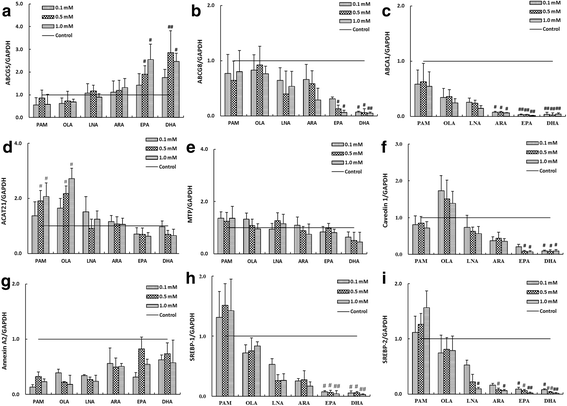Fatty acids modulate the expression levels of key proteins for cholesterol absorption in Caco-2 monolayer
- PMID: 29463265
- PMCID: PMC5819267
- DOI: 10.1186/s12944-018-0675-y
Fatty acids modulate the expression levels of key proteins for cholesterol absorption in Caco-2 monolayer
Abstract
Background: Fatty acids have been shown to modulate intestinal cholesterol absorption in cells and animals, a process that is mediated by several transporter proteins. Of these proteins, Niemann-Pick C1-Like 1 (NPC1L1) is a major contributor to this process. The current study investigates the unknown mechanism by which fatty acids modulate cholesterol absorption.
Methods: We evaluated the effects of six fatty acids palmitic acid (PAM), oleic acid (OLA), linoleic acid (LNA), arachidonic acid (ARA), eicosapentaenoic acid (EPA) and docosahexaenoic acid (DHA) on cholesterol uptake and transport in human enterocytes Caco-2 cells, and on the mRNA expression levels of NPC1L1, others proteins (ABCG5, ABCG8, ABCA1, ACAT2, MTP, Caveolin 1, Annexin-2) involved in cholesterol absorption, and SREBP-1 and SREBP-2 that are responsible for lipid metabolism.
Results: The polyunsaturated fatty acids (PUFAs), especially for EPA and DHA, dose-dependently inhibited cholesterol uptake and transport in Caco-2 monolayer, while saturated fatty acids (SFAs) and monounsaturated fatty acids (MUFAs) had no inhibitory effects. EPA and DHA inhibited cholesterol absorption in Caco-2 monolayer might be caused by down-regulating NPC1L1 mRNA and protein levels, which were associated with inhibition of SREBP-1/- 2 mRNA expression levels.
Conclusion: Results from this study indicate that functional food containing high PUFAs may have potential therapeutic benefit to reduce cholesterol absorption. Further studies on this topic may provide approaches to control lipid metabolism and to promote health.
Keywords: Caco-2 monolayer transport; Fatty acids; Intestinal cholesterol absorption; NPC1L1.
Conflict of interest statement
Ethics approval and consent to participate
Not applicable.
Consent for publication
Not applicable.
Competing interests
All authors declare that they have no competing interests.
Publisher’s Note
Springer Nature remains neutral with regard to jurisdictional claims in published maps and institutional affiliations.
Figures




Similar articles
-
Polyunsaturated fatty acids down-regulate in vitro expression of the key intestinal cholesterol absorption protein NPC1L1: no effect of monounsaturated nor saturated fatty acids.J Nutr Biochem. 2010 Jun;21(6):518-25. doi: 10.1016/j.jnutbio.2009.02.010. Epub 2009 May 14. J Nutr Biochem. 2010. PMID: 19443194
-
Regulation of intestinal NPC1L1 expression by dietary fish oil and docosahexaenoic acid.J Lipid Res. 2007 Feb;48(2):395-404. doi: 10.1194/jlr.M600325-JLR200. Epub 2006 Nov 18. J Lipid Res. 2007. PMID: 17114806
-
Oleic acid decreases the expression of a cholesterol transport-related protein (NPC1L1) by the induction of endoplasmic reticulum stress in CaCo-2 cells.J Physiol Biochem. 2011 Jun;67(2):153-63. doi: 10.1007/s13105-010-0058-y. Epub 2010 Dec 22. J Physiol Biochem. 2011. PMID: 21181463
-
Associations between Lifestyle-Related Diseases and Transporters Involved in Intestinal Absorption and Biliary Excretion of Cholesterol.Biol Pharm Bull. 2018;41(1):1-10. doi: 10.1248/bpb.b17-00690. Biol Pharm Bull. 2018. PMID: 29311470 Review.
-
ABCG5/ABCG8 in cholesterol excretion and atherosclerosis.Clin Chim Acta. 2014 Jan 20;428:82-8. doi: 10.1016/j.cca.2013.11.010. Epub 2013 Nov 16. Clin Chim Acta. 2014. PMID: 24252657 Review.
Cited by
-
A Fundamental Role for Oxidants and Intracellular Calcium Signals in Alzheimer's Pathogenesis-And How a Comprehensive Antioxidant Strategy May Aid Prevention of This Disorder.Int J Mol Sci. 2021 Feb 21;22(4):2140. doi: 10.3390/ijms22042140. Int J Mol Sci. 2021. PMID: 33669995 Free PMC article. Review.
-
Comparison of long-term effects of egg yolk consumption under normal and high fat diet on lipid metabolism and fatty acids profile in mice.Food Sci Biotechnol. 2019 Jan 23;28(4):1195-1206. doi: 10.1007/s10068-018-00545-w. eCollection 2019 Aug. Food Sci Biotechnol. 2019. PMID: 31275720 Free PMC article.
-
Sequential Extraction, Characterization, and Analysis of Pumpkin Polysaccharides for Their Hypoglycemic Activities and Effects on Gut Microbiota in Mice.Front Nutr. 2021 Nov 3;8:769181. doi: 10.3389/fnut.2021.769181. eCollection 2021. Front Nutr. 2021. PMID: 34805250 Free PMC article.
-
Herbal medicine in the treatment of patients with type 2 diabetes mellitus.Chin Med J (Engl). 2019 Jan 5;132(1):78-85. doi: 10.1097/CM9.0000000000000006. Chin Med J (Engl). 2019. PMID: 30628962 Free PMC article. Review. No abstract available.
-
Tisochrysis lutea F&M-M36 Mitigates Risk Factors of Metabolic Syndrome and Promotes Visceral Fat Browning through β3-Adrenergic Receptor/UCP1 Signaling.Mar Drugs. 2023 May 17;21(5):303. doi: 10.3390/md21050303. Mar Drugs. 2023. PMID: 37233497 Free PMC article.
References
-
- National Cholesterol Education Program (NCEP) Expert panel on detection, evaluation, and treatment of high blood cholesterol in adults (adult treatment panel III). Third report of the National Cholesterol Education Program (NCEP) expert panel on detection, evaluation, and treatment of high blood cholesterol in adults (adult treatment panel III) final report. Circulation. 2002;106(25):3143-3121. - PubMed
-
- Rivellese AA, Maffettone A, Vessby B, Uusitupa M, Hermansen K, Berglund L, et al. Effects of dietary saturated, monounsaturated and n-3 fatty acids on fasting lipoproteins, LDL size and post-prandial lipid metabolism in healthy subjects. Atherosclerosis. 2003;167:149–158. doi: 10.1016/S0021-9150(02)00424-0. - DOI - PubMed
MeSH terms
Substances
Grants and funding
LinkOut - more resources
Full Text Sources
Other Literature Sources
Medical
Research Materials
Miscellaneous

